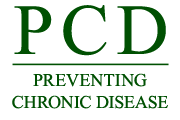PCD News Summary for Thursday, October 5

Notice to News Media – PCD Release Time and Embargo Policy:
CDC’s News Media Branch releases to reporters the PCD media packet every Tuesday afternoon between 12 and 2 pm.
Embargoed until Thursday, October 5, at 12:00 PM ET
A Diabetes Pay-for-Performance Program and Risks of Cancer Incidence and Death in Patients With Type 2 Diabetes in Taiwan
Diabetes pay-for-performance (P4P) programs were associated with lower risks of all-cause, cancer-specific, and diabetes-related deaths in Taiwan. Researchers conducted a study using three population-based databases in Taiwan, comparing patients with type 2 diabetes who enrolled in a P4P program with a similar group of patients who did not enroll in the P4P program. Primary end points of interest were risks of incident cancer and all-cause, cancer-specific, and diabetes-related deaths. Overall, the findings indicated that the diabetes P4P program was not significantly associated with lower risks of cancer incidence, but it was associated with lower risks of all-cause, cancer-specific, and diabetes-related deaths.
Melissa Newton
mnewton@cdc.gov
404-718-6281
Examining the Food Retail Choice Context in Urban Food Deserts, Ohio, 2015
In stores in urban Ohio food deserts, the most common healthy options available among all stores were canned vegetables, 100 percent juice, and diet soda. Measures of food retail choice contexts may provide a more precise indication of how and where to target future food environment interventions. Researchers evaluated every food retailer in two racially and economically matched neighborhoods from two metropolitan areas in Ohio to develop a new method for measuring retail food choices within neighborhoods. In the targeted neighborhoods, more than 40 percent of the population lived below the federal poverty level, and more than 70 percent identified as a racial/ethnic minority. They observed all food retail outlet types including convenience stores, gas stations, pharmacies, dollar stores, and ethnic and specialty food stores located in and on the periphery of neighborhood boundaries.
Melissa Newton
mnewton@cdc.gov
404-718-6281
###
Note: Not all articles published in PCD represent work done at CDC. In your stories, please clarify whether a study was conducted by CDC (“a CDC study”) or by another institution (“a study published by CDC”). The opinions expressed by authors contributing to PCD do not necessarily reflect the opinions of CDC or the institutions with which the authors are affiliated. PCD requests that, when possible, you include a live link to the article in your stories.
###
U.S. DEPARTMENT OF HEALTH AND HUMAN SERVICES
CDC works 24/7 protecting America’s health, safety and security. Whether diseases start at home or abroad, are curable or preventable, chronic or acute, stem from human error or deliberate attack, CDC is committed to respond to America’s most pressing health challenges.
- Page last reviewed: October 5, 2017
- Page last updated: October 5, 2017
- Content source:



 ShareCompartir
ShareCompartir